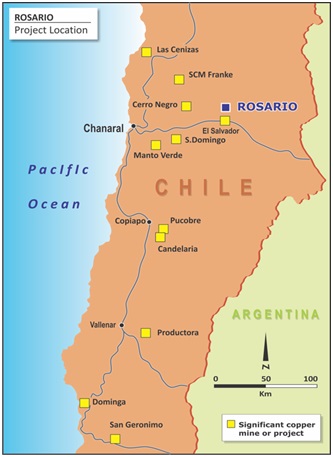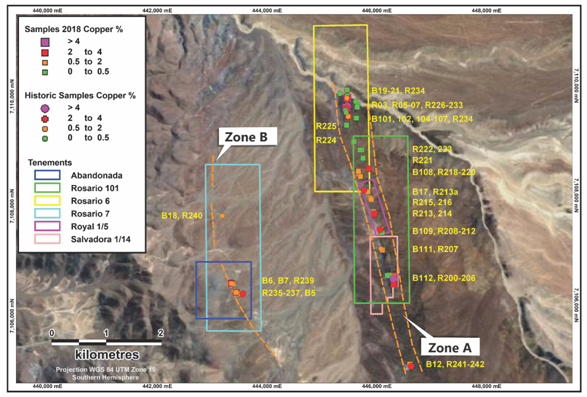Chile
The Rosario Project
The Rosario project is located approximately 120 kilometres east of the port city of Chanaral in the Atacama Region of northern Chile.
In June 2019, Variscan agreed to material amendments to the Rosario Project Option Agreement ('Option") with the vendors (refer to the ASX release of 1 July 2019). The renegotiation of the Rosario Option achieved two of the Company's goals: significantly reducing the upfront cash costs of the purchase, while also providing Variscan with an immediate interest in this highly prospective project.
Chile is a proven mining jurisdiction and is the largest producer of copper globally. The Rosario project lies about 20 kilometres north of the El Salvador mine (owned by CODELCO). It is one of the country’s larger copper operations, within a region of dense mining activity (all scales) and good copper endowment.
STRATEGIC LOCATION: ROSARIO

Initial Fieldwork
Initial field work conducted by Variscan in early 2018 validated the high grade copper potential of the Rosario Project. Selective rock chip and grab sampling by Variscan confirmed surface outcrops containing high grade copper. Assay results of samples recorded copper grades up to 4.82% Cu and silver grades up to 42g/t Ag. (ASX 11 April 2018).
PLAN OF ROCK & SAMPLING RESULTS AT ROSARIO

Mineralisation
Copper mineralisation at the Rosario Prospect is assessed to be related to the up flow of fluids along the NNW Mantos Gruesos Fault zone in probable mesothermal conditions and lateral inflow of the mineralizing solutions into permeable layers of the Mantos Gruesos unit. Oxide mineralisation also was transported into a secondary NW trending fault system. The lack of intense pyritization and the overall alteration characteristics indicates low sulphidation and suggest that the primary ore is made up mainly by copper sulphides. Copper mineralisation is hosted in the calcite infill of the main structure with thicknesses up to 20 m and in permeable strata in contact with this structure. In Northern Chile, this type of mineralized structures is common in the peripheries of intrusion related ore bodies and can constitute interesting targets for Cu-Ag or Cu-Au mineralisation.
Observed mineralisation comprises chrysocolla, minor brochantite and “almagres”, no primary or secondary copper sulfides were identified. It is hosted in the calcite infill of the Mantos Gruesos fault that can reach up to 20 m, and in the NW structures close to the intersection with the MGF. The small mines that are in the area are located at the crossings of these two structural systems were the mineralisation is hosted in the calcite and as coatings in fractures. In the central north part of the area copper oxides in volcanic sedimentary horizons (manto-type) were observed in the Mantos Gruesos unit away from the main structural zone, indicating that the mineralisation fluids flowed out of the fault channel into permeable volcanic-sedimentary layers.

